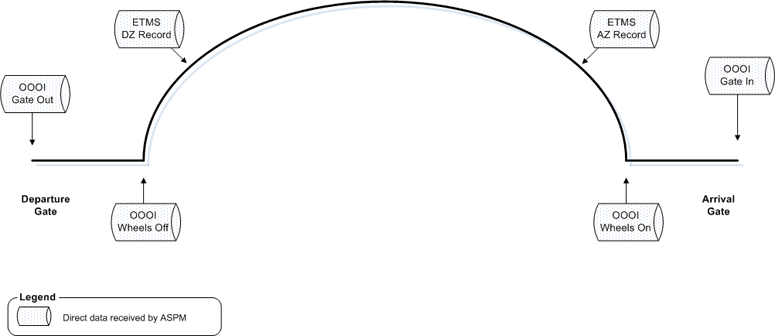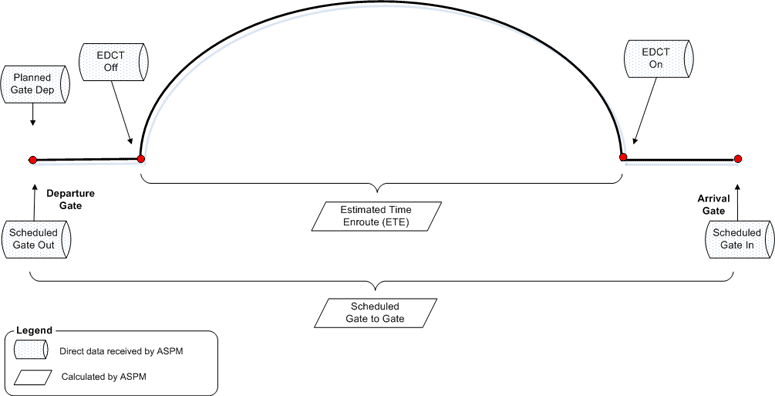APM: Flight Level
Contents |
Overview
The Individual Flight is the basic component of the APM calculations. The rest of the APM system documents the several data sets collected under the APM umbrella.
Actual Times (OOOI & TFMS)
APM begins by collecting actual points in time for flights. All points in time are stored as GMT Seconds Since 1980, or "GMT Seconds". APM uses GMT Seconds to make duration calculations easy. When times are displayed, they are converted to local time. The following graphic indicates the actual (observed) points in time that APM collects along the path of a typical flight. The two sources of this data are either OOOI or TFMS.
OOOI data (Gate Out, Wheels Off, Wheels On, and Gate In), is collected from electronic devices in aircraft from major carriers. This data is provided to APM from either a direct OOOI feed from ARINC on a next-day basis, and/or from the ASQP data published monthly by DOT.
TFMS data (Traffic Flow Management System) comes from the FAA's Air Traffic Control system and contains a wealth of information. The graphic below is only looking at the actual times used by APM.
APM focuses on air traffic to and from the ASPM 77 airports plus flights to and from anywhere by the 25 (or so) APM carriers. These top carriers do fly many international flights, so many international destinations are present in APM.
Calculations Part I (actual durations)
The following image illustrates the APM calculations that naturally flow from the several time observations from OOOI and/or TFMS data. APM calculates all durations in minutes. When both OOOI and TFMS data are present for a flight, ASPM calculates all of these as actual values. For records missing one more pieces of actual data, estimation techniques using available data are used to fill in missing values.
For the ASPM 77 airports, nearly 75% of all traffic has both OOOI and TFMS data on a next day basis.
The actual times calculated here are used to help estimate times for other flights when either TFMS or OOOI data is missing (more on this in the ASPM: Estimation Techniques and ASPM: Calculations Part III sections.
Schedule and Flight Plan (Flight Schedule Database & TFMS)
The following image illustrates the Schedule and Flight Plan times APM collects. Schedule and Flight Plan times allow APM to calculate delays.
Schedule Times are generally flight times published well in advance of the day of a specific flight. These times are typically included in the TFMS record. Missing data are supplemented by records from a database of flight schedules, and from the Computer Reservation System (CRS) data included in ASQP records. Scheduled Times provide a good reference point from the point of view of the passenger.
Flight Plan Times, on the other hand, come from the filed flight plan for each flight. These times are required to be filed no more than 24 hours in advance and are required to be updated if they are known to be more than an hour off. Flight Plan Times provide a good reference point for how each flight is handled once it is ready to depart.
There are many other flight plan times used by ATC which are reported in TFMS. For example, the ATC estimates Flight Plan Wheels Off and On times to assist with traffic management. APM focuses on the times depicted here as sufficient for the APM model.
EDCT Times are only present when a ground delay program is in effect at one or more airports. Generally, the ATC is constantly estimating where traffic will be. If a destination airport is expected to be congested, the ATC will initiate a ground delay program that will hold flights at their departing airport until the destination airport can accommodate them. For example, a severe thunderstorm can disrupt traffic at one airport and that will cause delays at many other airports sending flights to or expecting flight from an affected airport. In this sense, EDCT is a planned delay.
APM calculates delays using both Schedule and Flight Plan as reference points to provide a more complete picture of the Air Traffic Control System's operation and performance.




